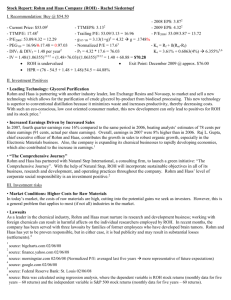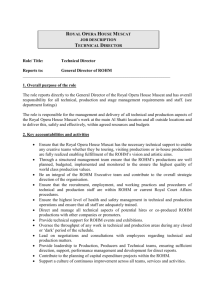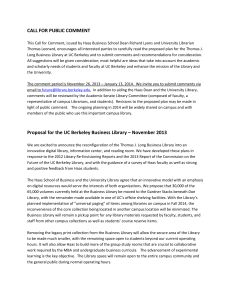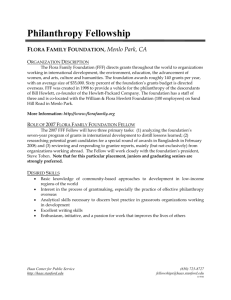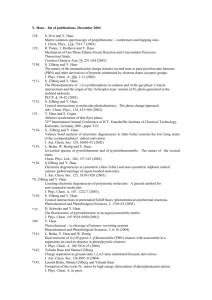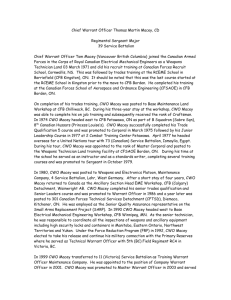sample_leadership_essay.doc
advertisement
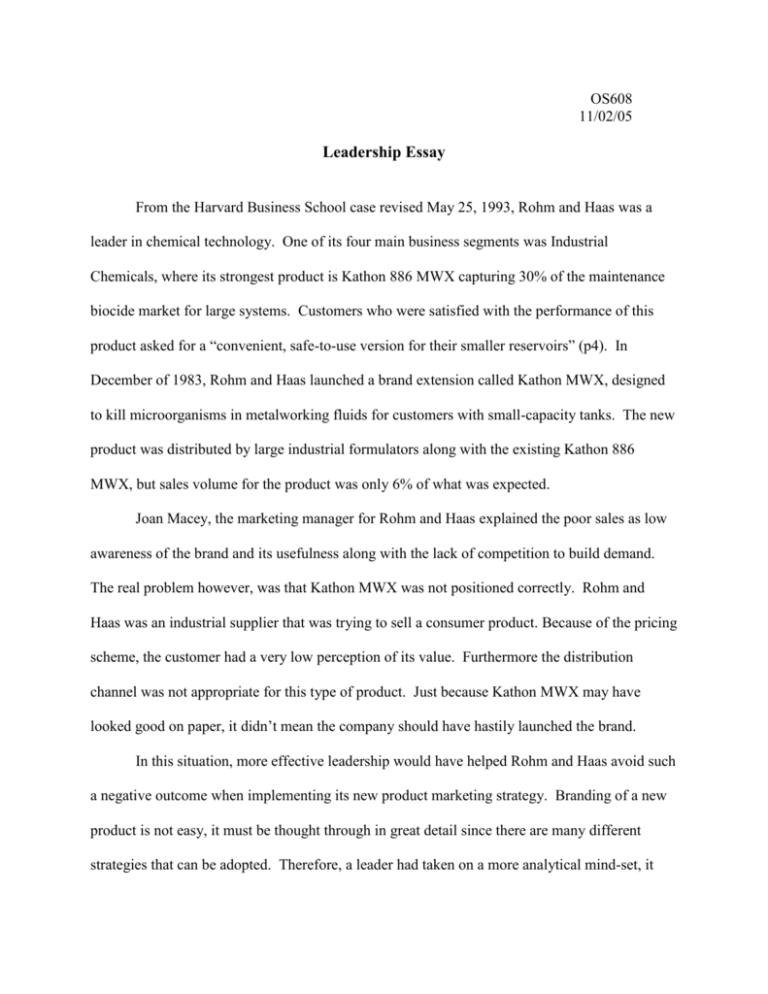
OS608 11/02/05 Leadership Essay From the Harvard Business School case revised May 25, 1993, Rohm and Haas was a leader in chemical technology. One of its four main business segments was Industrial Chemicals, where its strongest product is Kathon 886 MWX capturing 30% of the maintenance biocide market for large systems. Customers who were satisfied with the performance of this product asked for a “convenient, safe-to-use version for their smaller reservoirs” (p4). In December of 1983, Rohm and Haas launched a brand extension called Kathon MWX, designed to kill microorganisms in metalworking fluids for customers with small-capacity tanks. The new product was distributed by large industrial formulators along with the existing Kathon 886 MWX, but sales volume for the product was only 6% of what was expected. Joan Macey, the marketing manager for Rohm and Haas explained the poor sales as low awareness of the brand and its usefulness along with the lack of competition to build demand. The real problem however, was that Kathon MWX was not positioned correctly. Rohm and Haas was an industrial supplier that was trying to sell a consumer product. Because of the pricing scheme, the customer had a very low perception of its value. Furthermore the distribution channel was not appropriate for this type of product. Just because Kathon MWX may have looked good on paper, it didn’t mean the company should have hastily launched the brand. In this situation, more effective leadership would have helped Rohm and Haas avoid such a negative outcome when implementing its new product marketing strategy. Branding of a new product is not easy, it must be thought through in great detail since there are many different strategies that can be adopted. Therefore, a leader had taken on a more analytical mind-set, it 2 would have been able to position Kathon MWX more appropriately. The company saw a market demand, but did a shallow analysis and used easy techniques such as running the numbers. As Gosling and Mintzberg put it in The Five Minds of a Manager, they did nothing “beyond the superficialities of obvious analysis” (p. 4). Joan Macey needed to go deeper in to the analysis looking at data, assumption and limitations while inquiring into how others drew conclusions. This analysis could have helped her to realize that making Kathon MWX a brand extension of Kathon 886 MWX added no value to the product because no brand awareness existed. This was mainly due to the fact that Kathon 886 MWX it was distributed through formulators, so the end user never saw the label containing the name. Consequently, since the new product was designed for consumers, it would have been much smarter for Rohm and Haas to market it with a name that would suggest something about the product’s benefits and quality as well as be easy for customers to pronounce recognize and remember. Another way an analytical mindset would have benefited the new product’s launch was in choosing its distribution channels. According to a survey in the case, while customers do purchase metalworking fluids from large national formulators, the majority shop at small, local tool or supply shops. Since this product was seen as a consumer packaged good and was not only competing with metalworking fluid biocides, but also household cleaners, Rohm and Haas should have positioned it that way by making it available in these local stores. Aside from the lack of analysis from leaders in the organization, another cause of these mistakes was the lack of fit between product and company’s culture. Rohm and Haas had traditionally been an industrial supplier, distributing products in large quantities. As a result, the culture was not consumer product oriented and employees were not accustomed to designing and marketing a product for consumer use. Joan Macey’s failure to recognize and understand the 3 company’s culture and its affects on the success of Kathon MWX were a big factor in the product’s failure. For that reason, if she had adopted a more worldly mind-set, the results could have been different. Like Gosling and Mintzberg said “should we not be getting into worlds beyond our own - into other people’s circumstances, habit, cultures - so that we can better understand our own world”(p. 5). If Macey had understood that other employees in the organization were not in the habit of marketing a consumer product or part of a culture that fostered the necessary tools to do so, she could have taken a different approach to launching Kathon MWX. This new product needed more of a leader and less of a manager. As Kotter said in the 1990 article What Leaders Really Do, “Management is about coping with complexity. Leadership, by contrast is about coping with change” (p. 4). When launching its new product, Rohm and Haas didn’t just need someone to maintain order and do the administrative work in this situation, it needed someone to foster change in the organization and prepare people to think in terms of consumer packaged goods instead of strictly industrial needs. By setting a direction, aligning people, motivating and inspiring them, a leader could have had a positive impact on the capabilities and success of an organization when launching Kathon MWX. One of the best ways that Macey could have accomplished this was to adopt a coaching style of leadership. By teaching and advising those involved, the task of marketing a product in a foreign segment would not be as shocking or difficult. She should therefore have helped them to determine their role and responsibilities in developing this new product while giving them the necessary instruction and feedback. Making expectations clear and maintaining constant dialogue is also critical in the success of the project. Although this would have been time 4 consuming for Macey, she must realize that fostering this type of change in an organization is not easy. Hopefully Macey will learn form the mistakes that were made in launching Kathon MWX. In order to become a better manager she should “step back and reflect thoughtfully on [her] experiences” (Gosling p. 4). It is important to digest experiences and learn from them. This will help her in the future to adopt a more analytical mindset, gain a better understanding of the company’s culture, act more as a leader, establish a vision and foster change. 5 Works Cited Goleman, D. (2000). Leadership that gets results. Harvard Business Review, 78(2), 78-90. Gosling, J. & Mintzberg, H. (2003). The Five Minds of a Manager, Harvard Business Review, 81(11), 54-63. Kotter (1990). What leaders really do. Harvard Business Review, 68(3), 103-111.
